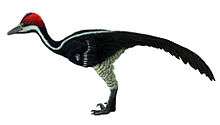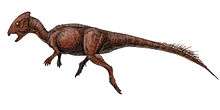Nemegt Formation
| Nemegt Formation Stratigraphic range: Late Cretaceous, 70 Ma | |
|---|---|
| Type | Geological formation |
| Location | |
| Region | Asia |
The Nemegt Formation (or Nemegtskaya Svita) is a geological formation in the Gobi desert of Mongolia, dating from the Late Cretaceous. It overlies and sometimes interfingers with the Barun Goyot Formation. Interfingering has been noted at the stratotype (Red Walls) and Khermeen Tsav. It consists of river channel sediments and contains fossils of fish, turtles, crocodilians, birds and a diverse fauna of dinosaurs. The climate associated with it was wetter than when preceding formations were deposited; there seems to have existed at least some degree of forest cover. Fossilized trunks have been also found.
There has been no absolute dating of the Nemegt Formation. It is, however, almost certainly early Maastrichtian c 71-69 Ma. Gradzinski and others considered a Campanian age possible but more recent research indicates otherwise. A Campanian age no longer seems credible, inasmuch as the Alagteegian (or lower Djadokhtan, at the locality "Chuluut Uul") has been radiometrically dated at about 73.5 Ma or even younger (a more recent K/Ar date is 71.6 +/- 1.6 Ma). The c 73.5 (or perhaps 72) Ma Alagteegian is separated from the Nemegt by the "classic" Djadokhtan (e.g. Bayan Dzag), later Djadohktan (represented by Ukhaa Tolgod) and Barungoyotian (Khulsan). All these intervening horizons almost certainly represent more than the 1.5 million years between the dated Alagteegian level and the onset of Maastrichtian time (72.1 million Ma according to current dating). Ergo the Nemegt is entirely Maastrichtian. See also Shuvalov, Sochava and Martinsson The Age of Dinosaurs in Russia and Mongolia. The presence of Saurolophus further supports an early Maastrichtian age as the same genus occurs in the early Maastrichtian Horseshoe Canyon formation.
Description
The Nemegt Formation (the upper beds) are composed of shales and sandstones that were deposited by ancient lakes, streams, and flood plains. The Altan Ula locality was described by Michael Novacek (1996) as "a canyon carved out of a very rich series of sedimentary rocks" with "steep cliffs and narrow washes". The presence of petrified wood, and the remains of Araucariaceae conifers indicate that the forests of the Nemegt were thickly wooded, with a high canopy formed by tall conifer trees. When examined, the rock facies of this formation suggest the presence of stream and river channels, mudflats, and shallow lakes. Sediments also indicate that there existed a rich habitat, offering diverse food in abundant amounts that could sustain massive Cretaceous dinosaurs.[1]
Flora and fauna of the Nemegt Formation
Coelurosaurs
Oviraptorosaurs
| Oviraptorosaurs reported from the Nemegt Formation | ||||||
|---|---|---|---|---|---|---|
| Genus | Species | Location | Stratigraphic Position | Material | Notes | Images |
|
Ajancingenia yanshini |
|
|
"Partial skeleton with skull [and five] partial postcrania."[2] |
An oviraptorid, also found in the Barun Goyot Formation. |
| |
|
Avimimus portentosus |
Avimimids. | |||||
|
Elmisaurus rarus |
"[Three] pedes [and a] manus."[2] |
A caenagnathid. | ||||
|
C. gracilis |
|
|
"Partial skeleton with skull, [four] partial skulls, [and] numerous skull and postcranial fragments."[2] |
|||
|
Nemegtomaia barsboldi |
An oviraptorid. | |||||
|
N. gobiensis |
"Partial postcranium."[3] |
|||||
|
Rinchenia mongoliensis |
"Skull and fragmentary postcranium."[3] |
An oviraptorid. | ||||
Paravians
| Paravians reported from the Nemegt Formation | ||||||
|---|---|---|---|---|---|---|
| Genus | Species | Location | Stratigraphic Position | Material | Notes | Images |
|
Adasaurus mongoliensis[4] |
"Partial skull and fragmentary postcrania."[5] |
| ||||
|
Borogovia gracilicrus |
"Partial hindlimbs."[6] |
A troodontid. | ||||
|
Gurilynia nessovi |
"Shoulder girdle and forelimb elements."[7] |
An enantiornithine. | ||||
|
Judinornis nogontsavensis |
"Vertebra."[8] |
A hesperornithine. | ||||
|
S. junior |
Reclassified as Zanabazar junior | |||||
|
Teviornis gobiensis |
An anseriform related to modern ducks and geese. | |||||
|
Tochisaurus nemegtensis |
A metatarsus.[6] |
A troodontid. | ||||
|
Zanabazar junior[4] |
"Skull with fragmentary postcranial skeleton."[6] |
A troodontid. | ||||
Other coelurosaurs
| Misc Coelurosaurs reported from the Nemegt Formation | ||||||
|---|---|---|---|---|---|---|
| Genus | Species | Location | Stratigraphic Position | Material | Notes | Images |
|
Alioramus remotus[4] |
A tyrannosaur, actually present in the Beds of Nogoon Tsav. Nemegt fossils reclassified as A. altai. |
| ||||
|
Alioramus altai |
A tyrannosaur. | |||||
|
Anserimimus planinychus |
"Incomplete postcranium."[10] |
An ornithomimid. | ||||
|
Bagaraatan ostromi |
"Fragmentary skull and associated postcranium."[11] |
A coelurosaur or uncertain classification. | ||||
|
Deinocheirus mirificus[4] |
"Forelimb elements, skull. Two new specimens together provide a nearly complete skeleton."[10] |
A gigantic ornithomimosaur. | ||||
|
Gallimimus bullatus[4] |
"[Three] nearly complete skeletons, complete postcranium, skull with associated frgamentary postcranium, [and] other fragmentary postcrania.",[10] and two full skeletons "[12] |
An ornithomimid. | ||||
|
Mononykus olecranus |
An alvarezsaurid. | |||||
|
Raptorex kreigsteni[13] |
A tyrannosaurid, may be a juvenile Tarbosaurus.[14] | |||||
|
Tarbosaurus bataar[4] |
"A skull and [Two] skeletons [15] | A tyrannosaur. Articulated skeletons are unusually common here. | ||||
|
Therizinosaurus cheloniformis[4] |
|
|
"Forelimb elements [and a] referred hindlimb."[16] |
A giant therizinosaur. | ||
Invertebrates
| Invertebrates of the Nemegt Formation | ||||||
|---|---|---|---|---|---|---|
| Genus | Species | Location | Stratigraphic Position | Abundance | Notes | |
| An ostracod. | ||||||
Mammals
| Mammals of the Nemegt Formation | ||||||
|---|---|---|---|---|---|---|
| Genus | Species | Location | Stratigraphic Position | Abundance | Notes | Images |
|
Buginbaatar transaltaiensis |
||||||
Ornithischians
| Ornithischians of the Nemegt Formation | ||||||
|---|---|---|---|---|---|---|
| Genus | Species | Location | Stratigraphic Position | Material | Notes | Images |
|
Barsboldia sicinskii |
"Sacrum [and] pelvis."[17] |
A hadrosaurid. |
| |||
|
Dyoplosaurus giganteus |
An ankylosaur. Formerly synonymized with Tarchia kielanae, now considered a nomen dubium.[18] | |||||
|
Homalocephale calathoceros |
A pachycephalosaur. | |||||
|
P. prenes |
"Complete skull with associated partial postcranium."[19] |
|||||
|
Saichania chulsanensis |
"Complete skull" | An ankylosaur, also found in the Barun Goyot Formation. | ||||
|
Saurolophus angustirostris |
"At least [fifteen] specimens, including articulated skull and postcranial skeleton."[17] |
A hadrosaurid. | ||||
|
Tarchia teresae[20] |
An ankylosaur. | |||||
Sauropods
| Sauropods reported from the Nemegt Formation | ||||||
|---|---|---|---|---|---|---|
| Genus | Species | Location | Stratigraphic Position | Material | Notes | Images |
|
Nemegtosaurus mongoliensis |
"Skull."[21] |
A titanosaur. |
| |||
|
Opisthocoelicaudia skarzynskii |
"Skeleton lacking skull and cervical series."[22] |
A titanosaur. | ||||
Fossil Eggs
| Fossil eggs found in the Nemegt Formation | ||||||
|---|---|---|---|---|---|---|
| Oogenus | Oospecies | Location | Stratigraphic Position | Material | Notes | Images |
|
Laevisoolithus sochavai |
"Whole egg with partly broken pole"[23] |
Laid by a bird or small theropod.[23] | ||||
|
Subtiliolithus microtuberculatus[23] |
"Eggshell fragments"[23] |
|||||
References
- ↑ Novacek, M. (1996). Dinosaurs of the Flaming Cliffs. Bantam Doubleday Dell Publishing Group Inc. New York, New York. ISBN 978-0-385-47775-8
- 1 2 3 4 5 "Table 8.1," in Weishampel, et al. (2004). Page 167.
- 1 2 "Table 8.1," in Weishampel, et al. (2004). Page 166.
- 1 2 3 4 5 6 7 8 9 10 11 12 13 Barsbold, R. (1983). "Carnivorous dinosaurs from the Cretaceous of Mongolia [in Russian]." Trudy, Sovmestnaâ Sovetsko−Mongol’skaâ paleontologičeskaâ èkspediciâ, 19: 1–120.
- ↑ "Table 10.1," in Weishampel, et al. (2004). Page 198.
- 1 2 3 "Table 9.1," in Weishampel, et al. (2004). Page 185.
- ↑ "Table 11.1," in Weishampel, et al. (2004). Page 213.
- ↑ "Table 11.1," in Weishampel, et al. (2004). Page 215.
- ↑ Norell, M.A.; Makovicky, P.J.; Bever, G.S.; Balanoff, A.M.; Clark, J.M.; Barsbold, R.; Rowe, T. (2009). "A Review of the Mongolian Cretaceous Dinosaur Saurornithoides (Troodontidae: Theropoda)". American Museum Novitates. 3654: 63. doi:10.1206/648.1.
- 1 2 3 "Table 6.1," in Weishampel, et al. (2004). Page 138.
- ↑ "Table 5.1," in Weishampel, et al. (2004). Page 112.
- ↑ http://www.dvidshub.net/image/1442492/gallimimus-slab#.U8V4urF5bAx
- 1 2 Michael G. Newbrey, Donald B. Brinkman, Dale A. Winkler, Elizabeth A. Freedman, Andrew G. Neuman, Denver W. Fowler and Holly N. Woodward (2013). "Teleost centrum and jaw elements from the Upper Cretaceous Nemegt Formation (Campanian-Maastrichtian) of Mongolia and a re-identification of the fish centrum found with the theropod Raptorex kreigsteini" (PDF). In Gloria Arratia; Hans-Peter Schultze; Mark V. H. Wilson. Mesozoic Fishes 5 – Global Diversity and Evolution. Verlag Dr. Friedrich Pfeil. pp. 291–303. ISBN 978-3-89937-159-8.
- ↑ Fowler DW, Woodward HN, Freedman EA, Larson PL, Horner JR (2011) Reanalysis of “Raptorex kriegsteini”: A Juvenile Tyrannosaurid Dinosaur from Mongolia. PLoS ONE 6(6): e21376. doi:10.1371/journal.pone.0021376
- ↑ http://www.dvidshub.net/image/1442496/skull-tarbosaurus-baatar#.U8V7LrF5bAw
- ↑ "Table 7.1," in Weishampel, et al. (2004). Page 152.
- 1 2 "Table 20.1," in Weishampel, et al. (2004). Page 441.
- ↑ Arbour, V. M., Currie, P. J. and Badamgarav, D. (2014), The ankylosaurid dinosaurs of the Upper Cretaceous Baruungoyot and Nemegt formations of Mongolia. Zoological Journal of the Linnean Society, 172: 631–652. doi: 10.1111/zoj.12185
- ↑ "Table 21.1," in Weishampel, et al. (2004). Page 465.
- ↑ Paul Penkalski; Tatiana Tumanova (2016). "The cranial morphology and taxonomic status of Tarchia (Dinosauria: Ankylosauridae) from the Upper Cretaceous of Mongolia". Cretaceous Research. in press. doi:10.1016/j.cretres.2016.10.004.
- ↑ "Table 13.1," in Weishampel, et al. (2004). Page 263.
- ↑ "Table 13.1," in Weishampel, et al. (2004). Page 270.
- 1 2 3 4 5 6 K. E. Mikhailov. 1991. Classification of fossil eggshells of amniotic vertebrates. Acta Palaeontologica Polonica 36(2):193-238
See also
- Barun Goyot Formation
- Djadochta Formation
- List of fossil sites
- Nemegt Basin
- List of dinosaur-bearing rock formations







